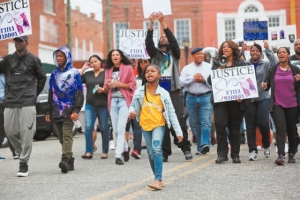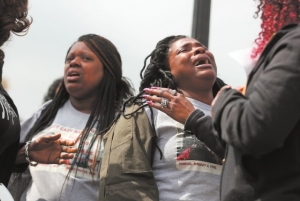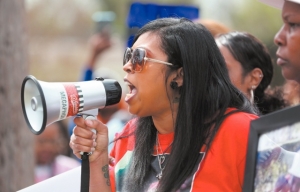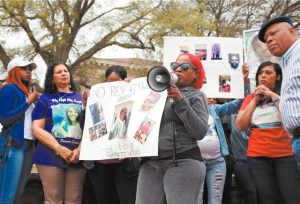A cry for justice
By John Joyce
Published in News on April 4, 2018 5:50 AM

News-Argus/CASEY MOZINGO
Jakeya Holmes, 6, leads the group of protesters chanting "We want justice. We want it now" down Ormond Avenue toward the Goldsboro Police Department on Tuesday. The peaceful protest was to ask that both law enforcement and members of the community do more about the unsolved murders in Goldsboro and Wayne County. Jakeya and her family were there for Shiheem Raiford, 21, who was murdered last year.

News-Argus/CASEY MOZINGO
Jasmine Pemberton screams out in pain as she and her two sisters Whitney Dean and Robin Solomon plead for someone to come forward with information about the murder of their brother Versean Jenkins, 21, killed in 2016.

News-Argus/CASEY MOZINGO
Tiffany Maddox calls out to one of the suspects in her daughter A'Tiya's murder who was in the crowd. A'Tiya was 19 when she was shot and killed in 2016.

News-Argus/CASEY MOZINGO
Tara Phillips, the mother of 18-year-old Shabazz Woods, who was killed in 2013, holds up a poster and speaks to the crowd gathering at the Wayne County Courthouse Tuesday. She was among the dozens of people protesting the number of unsolved murders in the community and asking for the support of law enforcement and those who may have answers to do more to help give a little closure to the victims' loved ones.
Tyrone Beamon Jr., 27, and his girlfriend Shondrea Millhouse, 21, were found bound, beaten and strangled to death inside his Mount Olive home in November 2013.
Their bodies were left for several days in a bathtub inside the home. Also in the house, and presumably there during the murders, were three children -- Beamon's son and Millhouse's two kids, who at the time were between the ages of 4 and 1.
Shabazz Woods, 18, was found shot to death between two apartments on Seymour Drive in January of that same year. It was the coldest night of the year and upon a neighbor discovering his body the next morning, he was found frozen stiff.
The stories of Goldsboro's unsolved murders are often gruesome and difficult to hear about.
More difficult for the families who participated in Tuesday's march for justice, which led from the Wayne County courthouse to the Goldsboro Police Department, are the unanswered questions.
"I'm like everybody else, I'm here for justice, and I am here for peace. And for anybody who has any news, please, pass it on," Beamon's mother, Wanda Green, said.
As many as 43 of the total 156 homicides to have taken place in the city since 1995 remain unsolved.
Through a megaphone, the mothers, fathers, sisters, aunts and cousins of the victims of Goldsboro's unsolved murders addressed a crowd of more than 60 people, pleading for the community to speak up and for the police department to do more to bring about the closure they seek for their slain loved ones.
Spearheading the event was Tiffany Maddox. Her daughter, A'Tiya, died in July 2016, when a bullet entered the car she was riding in and hit her. She was 19.
At one point, after the march to the police department, Maddox said while addressing the crowd that a man she knew to be a suspect in her daughter's killing was present. She first had to be consoled, then restrained, all the while reminding herself and the crowd that she had promised to remain peaceful.
After the rally, a more composed Maddox spoke about the march she helped organize.
"I'm pleased with the turnout. Every individual that inboxed me did show up, and they brought family members, so I am pleased with the turnout. Right now I'm just ready for some action," she said.
She said she hoped some hearts were touched in the crowd, specifically of those who might know who killed her daughter or one of the other victims, and that they might be moved to tell what they know.
She also hopes the police department is now motivated to do more to solve the open cases filling its filing cabinets.
"I'm hoping the Goldsboro Police Department can step in and do more -- as much as they can. I'm not back there, I'm not behind those walls," she said, nodding toward the police department.
"I don't know exactly what goes on, but all I can say is I hope they are not only dependent on hearsay, or dependent on word of mouth. They have enough evidence and enough information on my daughter's case where I believe it could be solved. So they just need to get to work and do what they need to do -- what they are supposed to be doing."
What is being done
Goldsboro Police Chief Mike West attended Tuesday's march. He said at times he felt the urge to step up to the megaphone, to address the crowd and try to answer some of the question or refute some of the accusations being lobbed at his department.
But he knew this was not his time to speak. He needed to listen.
"I thought it was a good turnout. It was more than I expected," he said.
Some of what was said, West admitted, was difficult to hear. But not the parts about the police. He said he was prepared to be "beaten up a little bit" by some of that.
The hard part, he said, was hearing the suffering.
"It is tough to stand there and listen to the families, you know, they've experienced it. They've experienced the loss."
Law enforcement can do its best to try to understand how the families of victims feel, but can never come close, he said.
"We've got no clue how they feel. And I think the raw emotion that was out there," he said, leaning back and letting out a heavy sigh. "And I know it's difficult for them and it is frustrating for them. So 90 percent of what they're out here for, and what I took away from what they're talking about, is getting the community involved, what the public knows, speak to law enforcement."
One sentiment all of those who took the megaphone shared, and West later echoed sitting in his office, is that the victims of these unsolved crimes didn't die alone.
"You had the perpetrator there, and you likely had witnesses there. And I don't understand how people can see a criminal act such as that and withhold -- just don't want to talk."
He told of a recent shooting at which, when police responded and tried to interview witnesses to learn what happened, the victim, still being tended to by EMS, told the witnesses not to talk to the police.
"The victim tells the witnesses at the scene not to say anything. And my officers are trying to interview the witnesses and (are hearing) 'I'm not talking to you,' 'I'm not talking to you,'" West said.
His clasped hands fell from under his chin and landed on his desk with a thud.
"Now, here is a person who just got shot, telling witnesses, 'don't say nothin,' and that's ... that's the struggle we have."
Fear of retribution
With Beamon's mother at the march Tuesday was Keith Waters, a cousin to Beamon and, as chance would have it, an uncle to A'Tiya.
He said the march brought up mixed emotions for him. While an arrest in either case would bring closure to him and might relieve some of the pain for his aunt or his sister, none of what has gone on in recent years is new.
"The fact is, Goldsboro is too small and too many generations have been raised here for this many unsolved murders. Goldsboro has always been like this though, it has always been a rough, dangerous little place," he said.
"The actuality is, when the microphones and these cameras and the lights leave, the people that committed these crimes, they are in the environment where retaliation is a way of life."
He said the street code -- the mantra of "keepin' it real" -- is too prevalent and too entrenched for anyone raised in the streets to have the courage to break free from and come forward to the police with information that might help solve a murder.
"And that's the battle. That's the battle. It's not just Goldsboro but any black, urban environment. The street and the law is two different laws, so it just depends where your heart is," he said.
The police don't run the streets, they monitor the streets. The cops conduct patrols and ride through the neighborhoods where crimes persist, then leave, he explained.
"They don't mingle with the affiliates in the streets so -- the street code is too prevalent here. It's going to take real ... it's going to take somebody with some (expletive) to come work in that building right there," he said, nodding at the police station.
Protecting witnesses
West said there is no guarantee that he or anyone else can give that a person who comes forward with information regarding an unsolved murder will not be outed.
"Where we struggle is, we get the anonymous information and then we follow up on it. And whether it leads to an arrest or not, it gets to a point where, if that's all we've got is that witnesses information that put us on to the arrest, then the dilemma for us is, do we reveal the identity of the witness and compromise what could be the case?" he said.
"Or, word gets out that, 'Yep, I called Crime Stoppers, gave information to the police that led to an arrest, then they outed me in court and now I'm fearing for my life.'"
The inability to protect witnesses who come forward and the inability to solve cases without the information witnesses possess leave the police department and the community facing off at the intersection of justice and injustice.
West explained that an investigator can be 100 percent convinced he or she knows who committed the crime, he or she can have some physical evidence, but there might be that one tiny bit of information that, without it, there is no chance a jury will convict. And there are no second chances, he said.
"Somebody can provide us with that little piece of information that kind of lets us know that maybe were on the right track. And then maybe it leads to us getting a suspect in to interview them. And then, if they think we know the whole story, then maybe they'll confess to it. And if we get a confession out of it, then maybe we're back to where we don't need that information that got us to a certain point," West said.
Where to go from here
Goldsboro Mayor Chuck Allen said millions of dollars have been spent in recent years shoring up manpower shortfalls and equipment limitations for the city's police department.
He said the families who marched on Tuesday do, however, need and deserve closure.
"I think the Goldsboro Police Department is doing what we can. I think we should take every case and maybe look at it, revisit it, let some new eyes look at it," he said.
Both Allen and West, independently of each other, said that not because of any perceived ineptitude but because fresh eyes might notice missed details, case files should be shared among detectives -- looked at by the investigator assigned to the case and then potentially handed over to another investigator for a second glance.
"We want to solve every murder, but so do they. I think the police department really tries. The key here is the community. As you heard repeatedly today, there are people right here today that know who shot who and who did this or who did that, and they're not talking," Allen said.
If the community will help the police, law enforcement would solve just about every one of the murders committed, he guessed.
Both West and Allen cited Crime Stoppers and the anonymous crime reporting apps that exist -- p3tipsubmit.com is an anonymous, web-based reporting tool -- for people who might know something but who are scared to come forward.
Sometimes, West said, police have everything they need to bring a case into court minus one minute detail that will cinch the case.
"It can be something very small that somebody thinks is absolutely of no use to us and they just think, 'ah, it's not worth it, it's not going to make a difference,'" he said. "But chances are it will make a difference."
